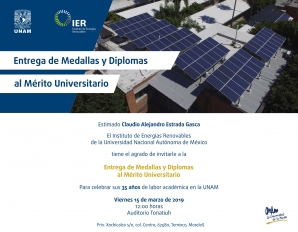Mostrando artículos por etiqueta: 2012 Memorias
Heat transfer model of a 1 kWth solar reactor for thermal dissociation of ZnO and SnO2 compressed powders
Abstract
The high-temperature solar processes are one of the promising alternatives to carry out materials transformations for chemical industry, like the calcinations of calcium carbonate for solar production of lime or cement, production of activated charcoal, etc. The production of energy carriers, such as the hydrogen, is a preponderant application that is focused on hydrocarbons substitution, along with very low or null greenhouse gas emissions. This method has the advantage of producing long-term storable and transportable energy carriers from solar energy. The thermochemical hydrogen production through water splitting is one of the most promising routes to obtain “solar hydrogen”.
H.I. Villafán Vidales, S. Abanades, H. Romero-Paredes, C.A. Estrada and C.A. Arancibia-Bulnes

Correction of the Concentrated Sunlight Spot’ s Drift of the CIE-UNAM Solar Furnace
Abstract
This paper discusses the methods implemented for the solution of the drift and backslash problems in the heliostat of the High Radiative Flux Solar Furnace recently built at the Center for Energy Research of the Universidad Nacional Autónoma de México, located at the geographical coordinates 18° 50' 24" North and 99° 15' 00" West. To solve the observed drift, various algorithms were analyzed for the calculation of the solar vector,and a closed loop through an electronic device was implemented which makes corrections to the position of the heliostat. Drift was corrected by means of unbalancing the heliostat.
R. Pérez-Enciso, E. Brito-Bazan, C. A. Arancibia-Bulnes, D. Riveros-Rosas, C. A. Perez-Rábago, J.J.Quiñones, C. A. Estrada
Correction of the Concentrated Sunlight Spot’ s Drift of the CIE-UNAM Solar Furnace

Degradation of the herbicide atrazine by photo-Fenton processes at solar photocatalytic plant level
Abstract
Atrazine, a herbicide commonly used around the world and listed by the European Union and by the US EPA as one of the priority pollutants, was subjected to photocatalytic degradation processes at pilot level on a solar photocatalytic plant located in Temixco, Morelos, Mexico. The photocatalytic reactor used for the degradation of the herbicide atrazine by photo-Fenton processes, is equipped with an online monitoring system of the main variables that characterize the reaction (COD, TOC, DO, pH and T). Atrazine, as a toxic compound, was degraded photocatalytically in more than 90% in a relatively short time (340 min) of exposure to solar radiation, reaching a level of mineralization (TOC) of 60% and a decrease of COD of more 50%. Toxicity tests of the contaminated solution were also conducted at the beginning and end of treatment with Artemia Franciscan Kellogg, finding that such toxicity was reduced by over 90%.
Antonio E. Jiménez-González, Carlos Antonio Pineda-Arellano, Cesar Pérez-Franco, Eduardo Iragorri-Sámano, Ana Gabriela Gutierrez-Mata e Ivan Salgado Tránsito.

